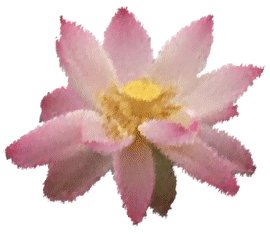
![]()
Case studies Ronchamp Chapel by Le Corbusier
Le Corbusier gave a plastic interpretation of an entire building and used one of the strangest, but also one of the most sculptural forms it is possible to imagine in the Pilgrimage chapel of Ronchamp. The building that formed a dark roof with complex curvature floats over curving walls.
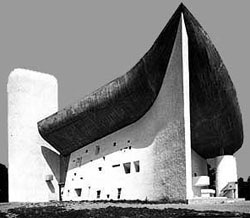
The southern "wall of light" is pierced by a multiplicity of irregular openings containing stained glass, filling the interior with colored light. Meanwhile, a ray of light penetrates through the junction between walls and roof; and 3 towers transmit light down from above into the chapel.
A place for private prayer, holding only 50 people, the main chapel is enlarged on the east side by an exterior altar for the use of pilgrims. A small gap which separates the shell of the roof from the outer walls makes the curvilinear surface of the roof seem to float above the interior, while the curved shape of the walls creates secondary spaces which are used as smaller chapels. The floor plan follows the natural slope of the terrain down towards the altar.

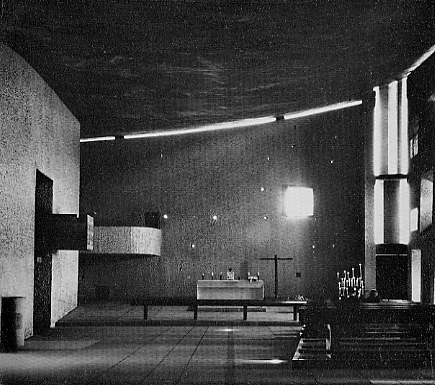
This
sprayed-concrete almost pure sculpture is situated at the top of a hill
above the river Sa˘ne surrounded by the Vosges Mountains was built of a
mixture of old Vosges stone and concrete. The plastic qualities of both
building materials have been exploited to the full and are perfectly
matched in the architectural form and siting of the chapel. The absence of
elements of a definite geometric form, the constant use of curvilinear
surfaces, the almost brutal presentation of materials in their raw state,
the return to traditional decorative forms (coloured glass, enamels,
special lighting effects).
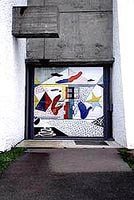
The exterior of the chapel and the surrounding area are both integrated in
such a way that the whole landscape is called in to participate in the
ritual work of architecture. The plastic forms of the liturgical objects
(altar, pulpit, etc.) in the open-air chapel become part of the landscape.
The billowing sail form of the roof plays its part in gathering in the
surrounding space, and the different materials and colours which
distinguish the surface of the roof from the architectural features
underneath.
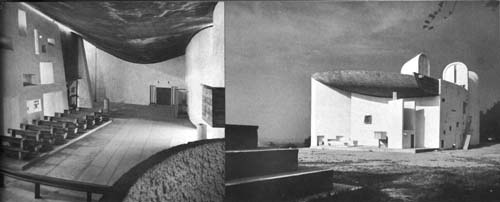
The materials used for the towers were chosen for their effectiveness in
diffusing light. The main door with its enamelled sheet with its brightly
coloured surface contrasts with the dark wall around it heightening the
formal effect of both. The system of 'light-funnels' in the south wall,
through which shafts of light enter through deep-set windows irregularly
arranged yet composed by the 'Modulor' system into a unified whole, is an
expression of the human values implicit in the wall itself.
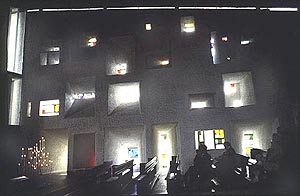 The way the holes and apertures increase the effect of the steeply sloping
wall. The coloured glass in the openings causes a play of light which
unburdens the concrete weight of the wall, rendering it airy and spacious.
The traditional role always assigned to coloured windows in a church -
especially in the French tradition -is retained and revivified. The roof
rests on slender stanchions hidden in the cavity wall, from which its is
separated by a band of light seen clearly in the top of the picture right
this giving the roof the effect of floating.
The way the holes and apertures increase the effect of the steeply sloping
wall. The coloured glass in the openings causes a play of light which
unburdens the concrete weight of the wall, rendering it airy and spacious.
The traditional role always assigned to coloured windows in a church -
especially in the French tradition -is retained and revivified. The roof
rests on slender stanchions hidden in the cavity wall, from which its is
separated by a band of light seen clearly in the top of the picture right
this giving the roof the effect of floating.
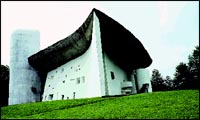
The site's hilltop was the main generator for the chapel's form. The four exterior walls curve and bend in response to the "acoustics" of the landscape: "the curved walls simultaneously gather and open to the landscape. . . to give a suggestion of the great extent of the landscape, far beyond the building's boundary. The landscape encouraged Le Corbusier to take an organic approach to designing the chapel.
The design is specific to the site, to its topography, history and sacred purpose. It has been described as being like a transmitter and receiver of spiritual messages to and from the surrounding countryside. It can be concluded that the design focuses much on the site to make a pilgrimage journey into the chapel. Regarding the chapel's design, a blend of new and old in the 50's constitute the design that gives a spiritual space whole. The usage of brilliant lighting in unconventional way from the site's orientation and also the floating ness of the structures that gives a spiritual feel to the chapel. Hence the achievement of spiritual of the supreme creator achieved in the chapel.
Previous Next
![]() This
is a thesis website by ressox studio.
This
is a thesis website by ressox studio.

